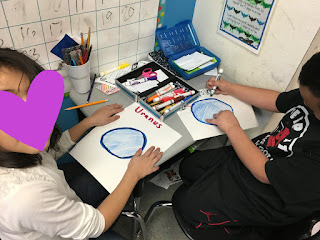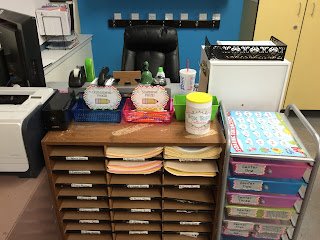This week in reading, we read a story called The Night the Moon Fell. This story is a myth that explains why we have stars. It's a fun story, but I wanted to do more with it. I decided to set the stage to engage by making the room look like outer space. However, since the classroom environment was going to be so engaging, the work they had to do needed to be difficult. I couldn't surround us with stars and then just have students pull the theme from task cards.
One of my teammates helped me with this classroom transformation. We hung up blackout curtains (since the trash bags didn't work well enough last time). We put glow in the dark stars and planets around the room. We also hung some white Christmas lights from the ceiling. I borrowed another teacher's blacklights again. (I'm planning on creating a Donor's Choose project to get some classroom flip items.) I also bought 2 little toys that shine stars on the ceiling.
The Christmas lights gave us a little bit more light to work by.
Stars on the ceiling
As you can see, the sunlight is strong out here in the desert! I also am in an Eastward facing classroom, so the sun is especially bright in the morning. I'm not really sure how I'm going to keep the light from just streaming in. I could double up on curtains or use the trash bags and the curtains to block the light-that is probably what I will try next time.
Since my teammate and I were working together this time, we had 46 students in the room. We watched some intro videos and talked about the 8 planets. Students then filled out a card with their first and second choice of planets to research. After that, we put on a 20 minute video so we could group the students in pairs.
I decided to have the students research, write reports, and create PowerPoint presentations about their chosen planet. My class did a research project in the fall on Mexico, the United States, and Cameroon. However, they worked in groups of 7 or 8 to complete their research, reports, and a poster. I also did not have students research online last time. Instead, I printed out information for them to read through.
This time, I decided to have students use kiddle.co to research in pairs. I created a list of 10 questions for students to answer. The students were asked to equally share the responsibility of answering the questions.
I really liked the search results that came up on Kiddle. Many students asked for help finding information, but I think it was because they didn't know how to read the articles to look for answers to their questions. I checked student's answers as they were working, and I did find students making errors. For example, many students said their planet had one moon or that a year lasted 1 year/365 days and that a day lasted 1 day/24 hours. So, when I saw students with the wrong answers, I told them that I didn't think they were correct, and we searched for the information together. Overall, the students did an excellent job on their first (almost) independent research project!
I created these PowerPoint backgrounds and added word/photo layouts so that students could easily add text and photos to the PowerPoint. Once students answered all of their questions, they started on their PowerPoint presentations. Students were instructed to use the answers to their questions as information in the slides. I showed the students how to download images of planets from Kiddle, and then insert them in the designated spot on their slides. I also went over the PowerPoint rubric with the students before they even began their research.
We borrowed 5th grade's laptop cart so that everyone could research their planet at the same time. It was time consuming! We had to open kiddle on each laptop (although I think my students could have navigated to the website). And we had to use a usb drive to put the PowerPoint presentation on each desktop. Then, when our laptop time was up, we had to go around and save the presentations back to the usb drive. Ugh! It would have been so much easier if we could have used Google Classroom. Unfortunately, my district hasn't figured Google Classroom out yet. (Our school website is on the District website, and we don't have an alternate one.)
It took 2 entire mornings for the students to finish their research and presentations. As students finished, they started on construction paper posters for their planets. The students still need to write a report about their planet. For now, I plan on using these mini reports from Only Passionate Curiosity. However, I did create a rubric for independent reports. Some of my higher students/fast finishers might be more interested in that.
Students completed their mini reports on Friday. Some students realized that they hadn't written down enough information under their questions. For example, for the temperature of the planet, there was a pair who wrote "warm to cold". Therefore, we had to look up the planet information again for some students.
Planet Posters
Total Engagement!
Throughout this past week, I worked with students on some speaking skills. We worked on projecting our voices so that students in all parts of the room could hear what we were saying. We practiced making eye contact and not hiding behind our papers.
On Thursday at 1:00, six groups of students went to classrooms throughout the school to make presentations about their planets to the students in those classrooms. The students used their own slideshows (I did edit the shows for spelling/grammar). I printed out the slides and each student read one, while it was one person's job to run the show. I only watched one group, but I was told that they all did a great job! The principal even sat it in on one of the presentations. I am so proud of our second graders!
Presentations
I love how intent the presenters and the kindergarten audience is!
Problems/What Didn't Work
Besides the technology problems of getting the laptops up and running, the biggest problem was that students accidentally deleted their slides! There were 5 slides in the presentation, and I helped probably 8 groups get back slides they had deleted. Unfortunately, I could find no way to add the slides in from the original file. If I had the background that I'd created, then I could have formatted the slides. However, I only brought the slideshow, not the backgrounds.
Some students had a harder time than others with downloading and inserting pictures. There were a couple of groups that I had to help download every picture they used in their show. Our students also do not have typing skills. Our district has a typing program that we are supposed to use. Unfortunately, we haven't found the time to use it between the math and reading computer programs students have to use each day, too. Nevertheless, I think students actually did pretty well with typing on their PowerPoints.
Another problem was having to go around with the flash drive to save every single slideshow. We have to figure out another way for students to be able to access a digital file, work on it, and turn it in! It was exhausting to go around to each pair. My school district said that I can't use Google Classroom. So I set up a class email and dropbox account for next time.





































































